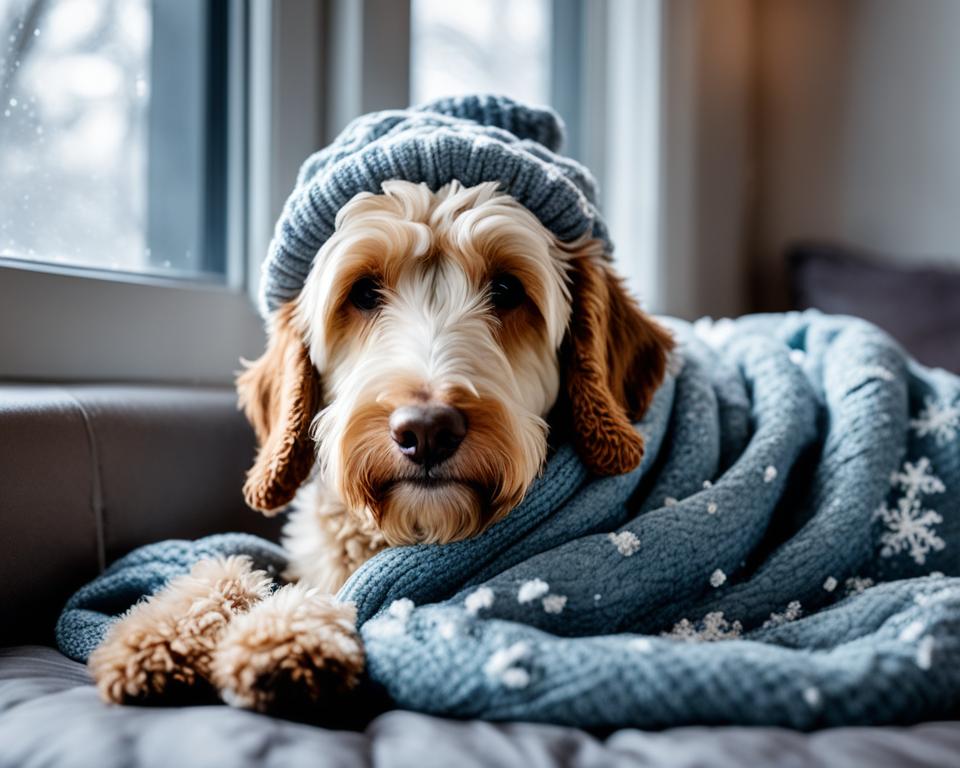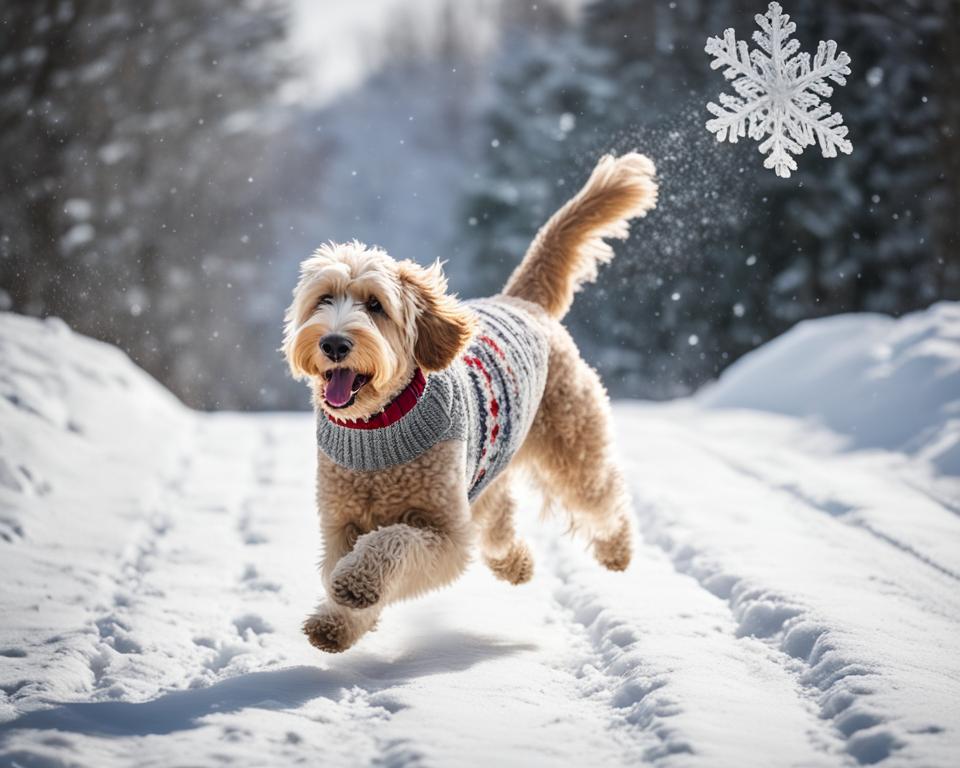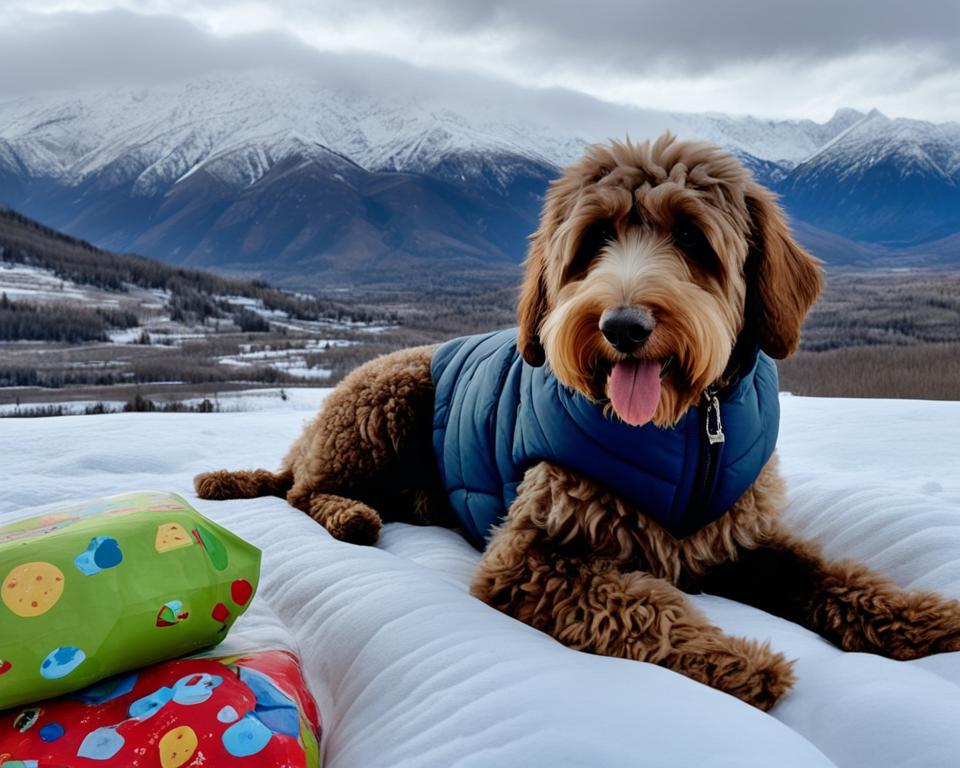Labradoodles, like all dogs, need extra care during the winter months to keep them safe and comfortable. Despite their fur, dogs can still experience cold-related health issues such as frostbite and hypothermia. It’s important to take preventive measures and provide the right care to ensure your Labradoodle stays healthy and happy in the cold weather.
Key Takeaways:
- Labradoodles require special care during winter to prevent health issues associated with cold weather.
- Frostbite and hypothermia are serious conditions that can affect Labradoodles. Recognize the signs and take appropriate actions to protect your pet.
- Dressing your Labradoodle in a coat or sweater can provide additional warmth, but limit their outdoor time in freezing temperatures.
- Provide cozy bedding and moisturize your Labradoodle’s skin to ensure they stay comfortable indoors.
- Limit outdoor time, especially in extreme cold, and exercise your Labradoodle indoors to maintain their health.
Recognizing and Preventing Frostbite and Hypothermia in Labradoodles
Frostbite and hypothermia are two serious conditions that can affect Labradoodles during the winter months. It’s important for dog owners to be aware of the signs and take preventive measures to protect their furry companions from these winter health risks.
Recognizing Frostbite
Frostbite occurs when a dog’s body gets cold, causing the blood to be pulled away from the extremities. Labradoodles, with their thick fur, are more resistant to cold weather than some other dog breeds. However, they are not immune to frostbite.
The signs of frostbite in Labradoodles include:
- Pale or grey skin
- Hardness and coldness in the affected area
- Lack of sensitivity or pain in the area
If you notice any of these signs on your Labradoodle, it’s important to take immediate action to prevent further damage.
Preventing Frostbite
To prevent frostbite in your Labradoodle, consider the following winter health tips:
- Limit outdoor time in extreme cold weather.
- Provide appropriate shelter, such as a heated dog house, for your Labradoodle when they are outside.
- Monitor your Labradoodle’s behavior during outdoor activities for any signs of discomfort.
- Be aware of potential hazards, such as icy surfaces and toxic substances like antifreeze.
Recognizing Hypothermia
Hypothermia occurs when a dog’s body temperature drops below normal due to prolonged exposure to cold temperatures. Labradoodles can be especially susceptible to hypothermia if they are left outside for extended periods in freezing temperatures.
The symptoms of hypothermia in Labradoodles include:
- Shivering
- Lethargy and weakness
- Slowed heart and breathing rates
If you observe these symptoms in your Labradoodle, it’s crucial to act quickly to prevent further complications.
Preventing Hypothermia
To protect your Labradoodle from hypothermia, follow these winter safety precautions:
- Limit outdoor time in extremely cold temperatures.
- Provide your Labradoodle with a warm and insulated shelter.
- Ensure your Labradoodle has appropriate clothing or a coat to keep them warm during outdoor activities.
- Keep an eye out for icy surfaces and potential hazards, such as frozen bodies of water.
| Type | Frostbite | Hypothermia |
|---|---|---|
| Definition | A condition caused by freezing temperatures, leading to damage in the skin and tissues. | A dangerous drop in body temperature due to prolonged exposure to cold weather. |
| Causes | Exposure to freezing temperatures, especially in unprotected areas like the ears, tail, and paws. | Prolonged exposure to cold temperatures without adequate protection or shelter. |
| Signs and Symptoms |
|
|
| Prevention Tips |
|
|
Dressing Your Labradoodle for Winter
While Labradoodles have a thick coat, some dogs may still need extra protection from the cold. Consider using a sweater or coat for your Labradoodle, especially if they have a thin coat or short hair. The coat should cover the neck to the tail and protect the belly.
It’s important to keep in mind that even with a coat, it’s not advisable to keep your dog outdoors for too long in freezing temperatures. Prolonged exposure to extreme cold can still pose risks to your Labradoodle’s health, such as frostbite and hypothermia.
Additionally, pay close attention to your Labradoodle’s paws. Keeping them dry is essential in preventing discomfort and potential damage due to ice, snow, and harmful substances like rock salt. Consider using booties specifically designed for dogs to provide additional protection and insulation.
Key Points:
- Labradoodles with thin coats or short hair may benefit from wearing a sweater or coat.
- The coat should cover the neck to the tail and protect the belly.
- Avoid keeping your Labradoodle outdoors for too long in freezing temperatures, even with a coat.
- Ensure your Labradoodle’s paws stay dry and consider using booties for added protection.
Providing Cozy Bedding and Moisturizing Your Labradoodle’s Skin
To ensure your Labradoodle stays warm and comfortable indoors during the winter, it’s important to provide them with cozy bedding in a warm spot away from drafts and cold floors. This will not only help prevent joint stiffness but also keep your furry friend cozy during those chilly winter nights.
Additionally, cold weather can cause dry skin in Labradoodles. To combat this, it’s essential to moisturize your Labradoodle’s skin with a skin and coat supplement or natural alternatives like coconut oil. Pay special attention to their paws, ears, and tail, as these areas may become dry or crack in the winter. Applying coconut oil can help keep these areas moisturized and protected, keeping your Labradoodle’s skin healthy and comfortable throughout the season.

Tips for Cozy Bedding and Moisturizing Your Labradoodle’s Skin
| Tip | Description |
|---|---|
| 1. Provide cozy bedding | Choose a warm spot away from drafts and cold floors to keep your Labradoodle comfortable and prevent joint stiffness. |
| 2. Moisturize their skin | Apply a skin and coat supplement or coconut oil to keep your Labradoodle’s skin hydrated and protected from dryness and cracking. |
| 3. Pay attention to paws, ears, and tail | These areas are particularly prone to dryness and cracking, so apply moisturizer to keep them healthy and comfortable. |
Limiting Outdoor Time and Exercising Your Labradoodle
While it’s important for Labradoodles to get exercise, it’s essential to take winter safety precautions and limit their outdoor time during the colder months. Extreme cold temperatures, ice, and snow can pose hazards to dogs, and it’s crucial to prioritize their well-being. Here are some tips for providing essential winter care for Labradoodles and ensuring their health and happiness:
1. Frequent Walks and Playtime
Take your Labradoodle for frequent walks and playtime to provide them with mental and physical stimulation. Engaging in exercise helps maintain their health and prevents potential weight gain during the winter months. This activity also strengthens the bond between you and your furry friend.
2. Bring Them Inside
When the temperature drops, it’s crucial to bring your Labradoodle inside to keep them safe and warm. Extreme cold temperatures can be dangerous for dogs and may lead to frostbite or hypothermia. Provide a cozy indoor space where your Labradoodle can relax and remain comfortable during the winter season.
3. Labradoodle Puppies and Cold
If you have a Labradoodle puppy, it’s essential to take extra precautions during winter. Puppies are more susceptible to the cold due to their smaller size and developing immune systems. Ensure they are adequately protected by limiting their exposure to cold weather and providing them with proper shelter and warmth.
4. Indoor Games and Puzzle Toys
When outdoor conditions are unfavorable, you can still provide mental and physical stimulation to your Labradoodle through indoor games and puzzle toys. These activities help keep them engaged and entertained, preventing boredom during the winter season.
5. Emphasize Safety and Well-being
Remember to prioritize your Labradoodle’s safety and well-being during the winter months. Avoid exposing them to extremely cold temperatures, icy surfaces, and hazardous substances. Always supervise your Labradoodle during outdoor activities and be aware of potential risks in your environment.

| Essential Winter Care for Labradoodles | Winter Care for Labradoodle Puppies | Labradoodle Winter Safety Precautions |
|---|---|---|
| Limit outdoor time in extreme cold | Be extra cautious with Labradoodle puppies | Supervise outdoor activities and environments |
| Provide appropriate shelter | Limit exposure to cold weather | Avoid icy surfaces and hazardous substances |
| Engage in frequent walks and playtime | Ensure proper warmth and protection | Prevent potential risks and accidents |
| Emphasize mental and physical stimulation | Supervise Labradoodle puppies outdoors | Keep Labradoodle’s safety as a top priority |
Additional Winter Care Tips for Labradoodles
In order to provide comprehensive winter care for your Labradoodle, there are a few more tips to consider. First and foremost, be mindful of their diet. With decreased activity during the cold months, it’s important to avoid overfeeding your dog to prevent weight gain. Maintain a balanced diet and monitor their calorie intake accordingly.
Another essential aspect of winter care is ensuring that your Labradoodle always has access to fresh water. Even in cold weather, dehydration can still occur. Keep their water bowl filled and check it regularly to make sure it hasn’t frozen over.
Grooming plays a crucial role in winter care as well. Regularly brush your Labradoodle’s coat to keep it clean and well-insulated. This helps to remove any matting and keeps their fur in optimal condition. Additionally, after outdoor playtime, it’s important to brush off any snow or ice from their fur to prevent the formation of ice balls.
Lastly, be cautious of toxic substances that can be harmful to your Labradoodle during winter. Antifreeze, which is commonly used in cars, can be extremely dangerous if ingested. Keep it stored safely and always check for any spills. Furthermore, it’s crucial to never leave your Labradoodle unattended in a car during winter, as temperatures can quickly drop to dangerous levels.
FAQ
Why is winter care important for Labradoodles?
Winter care is important for Labradoodles to protect them from cold-related health issues such as frostbite and hypothermia.
How can I recognize frostbite and hypothermia in my Labradoodle?
Signs of frostbite include pale or grey skin, hardness, and coldness. Symptoms of hypothermia include shivering, lethargy, weakness, and slowed heart and breathing rates.
How can I prevent frostbite and hypothermia in my Labradoodle?
To prevent frostbite and hypothermia in your Labradoodle, monitor their behavior, limit outdoor time in extreme cold, provide appropriate shelter, and be aware of potential hazards such as icy surfaces and toxic substances.
Is it necessary to dress my Labradoodle for winter?
While Labradoodles have a thick coat, some dogs may benefit from wearing a sweater or coat in cold weather, especially if they have a thin coat or short hair.
How should I dress my Labradoodle for winter?
Dress your Labradoodle in a sweater or coat that covers the neck to the tail and protects the belly. However, avoid keeping them outdoors for too long in freezing temperatures.
How can I provide cozy bedding for my Labradoodle during winter?
Provide cozy bedding in a warm spot away from drafts and cold floors to prevent joint stiffness and keep your Labradoodle comfortable during winter nights.
How can I moisturize my Labradoodle’s skin during winter?
Moisturize your Labradoodle’s skin with a skin and coat supplement or coconut oil to prevent dryness and cracking. Pay special attention to their paws, ears, and tail.
Should I limit my Labradoodle’s outdoor time in winter?
Yes, it is important to limit your Labradoodle’s outdoor time during winter to prevent exposure to extreme cold temperatures, ice, and snow. Bring them inside when the temperature drops.
How can I exercise my Labradoodle indoors during winter?
You can provide mental and physical stimulation to your Labradoodle through indoor games and puzzle toys. Regular exercise helps maintain their health and prevents weight gain.
Are there any additional winter care tips for Labradoodles?
Yes, additional winter care tips include avoiding overfeeding, ensuring access to fresh water, regular grooming, and being cautious of toxic substances like antifreeze.

Leave a Reply